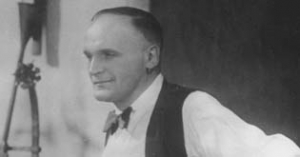Biography
Arthur (Artur) Robison was born June 25, 1888, in Chicago as the son of a German-American family. (The biographical data are spare and based on contradictory short portraits from the 1920s that cannot be checked.) He attended schools in the USA and Germany where the family returned to in 1895. After graduating from school in 1906, he studied medicine and obtained his MD degree in Munich. For a short while, he worked as a medical practitioner in Berlin. "As early as 1911, however, I felt the need to perform on-stage. At first, I studied languages and then I returned to America, where I worked as an actor at a German-American theater for almost a year." (Robison, 1928).
After the death of his father in 1914, Robison returned to Germany and started to work in the film business. According to himself (1925/1928), he directed three respectively four movies in 1915/1916. In 1916, Robison worked at a company run by the actress and producer Ly Synd. In 1916/1917, he wrote the screenplay for the first film of the Lu Synd series "Die Frau mit den zwei Seelen". "The author explores the matter of noctambulism, which correlates to her somewhat occult tendencies. He bestows upon the title character the wonderful gift of being able to look into the future and change the aftermath of certain events while sleepwalking." (Illustrierte Kino-Woche, No. 24, 1916).
Subsequently, he wrote and directed "Nächte des Grauens", starring Werner Krauß, Emil Jannings, and Hans Mierendorff. Possibly, he also collaborated on the third Lu Synd movie, "Des nächsten Weib", which was censored in August 1916. "In 1917, the young filmmaker began his years of travel. He worked both in Switzerland and in the United States." (Film-Kurier, 9/30/1925).
In 1921, Robison worked as a dramatic advisor and an author at the Deutsche Mutoskop- und Biograph GmbH. He wrote the screenplay for "Die Finsternis und ihr Eigentum", which was based on a novel by Anton von Perfall. For the Mutoskop company he also wrote and directed "Zwischen Abend und Morgen" ("Between Evening and Morning"), the "spook of one night". The movie was filmed by the cinematographer Fritz Arno Wagner who also collaborated with Robison on his most famous film, the "nocturnal hallucination" "Schatten" ("Warning Shadows").
"The plot is determined by shadows, bizarrely-formed shadows, shadows of juggling hands that are thrown onto the wall, shadows swallowing everything that is alive, shadows announcing future events. The filmmaker has masterfully conquered giant obstacles, and the result is an artistic achievement that will help to spread the reputation of the German film all over the world." (Kinematographische Monatshefte, May 1923). At first, "Warning Shadows" was published without titles, later it was often supplemented by intertitles or a psychological introduction.
Due to Robison’s great success, Erich Pommer offered him a contract at the Ufa film studios where he directed the elaborate costume dramas "Petro, der Korsar" and "Manon Lescaut". "These films feature virtuosic technical means and lively acting. They need to be rediscovered. As far as Pommer productions are concerned, they stand for the ambitious entertainment films aiming at a large audience. The director handles the cinematographic models very well. They add up to a story, no longer predetermined but reinvented. Above all, these films baffle the viewer by their technical brilliance – a trademark emphasized in many contemporary reviews." (W. Jacobsen: Erich Pommer, 1989).
Robison’s operetta film "Der letzte Walzer", starring Willy Fritsch and Liane Haid, was the first movie in Germany to be published under the label Parufamet and one of the few films that were distributed in the United States within the context of a German-American treaty. In early 1926, Robison was supposed to direct "Kopf hoch, Charly!" after a screenplay by Robert Liebmann. Eventually, however, the movie was completed by Willi Wolff and the leading role was played by Ellen Richter. Robison’s artist melodrama "Looping the Loop" was screened on the occasion of the opening of the new Ufa building Universum, which was located on Lehniner Platz.
The location shots in "Looping the Loop" were filmed in London, where Robison also shot the British International Pictures production "The Informer". The screenplay was based on the novel by Liam O’Flaherty. In 1935, John Ford directed the remake. The movie was produced both with and without sound, thus marking Robison’s transition to sound film.
Metro-Goldwyn-Mayer asked him to come to Hollywood to direct German and French versions of American productions for the European market. In Hollywood, Robison directed "Mordprozeß Mary Dugan", "Jenny Lind", and "Quand on est belle" ("When She"s Pretty"). After his return to Germany in 1933, Robison continued to work for the Ufa and directed both German and French versions of "Des jungen Dessauers große Liebe", "Fürst Woronzeff" and "Mach" mich glücklich". In late 1935, he shot the first sound version of Heinz Ewers’ doppelganger story "Der Student von Prag" for the production company Cine-Allianz. The screenplay was co-written by Hans Kyser and the leading role was played by Adolf Wohlbrück.
While still working on "Der Student von Prag", Arthur Robison died on October 20, 1935, in Berlin.
